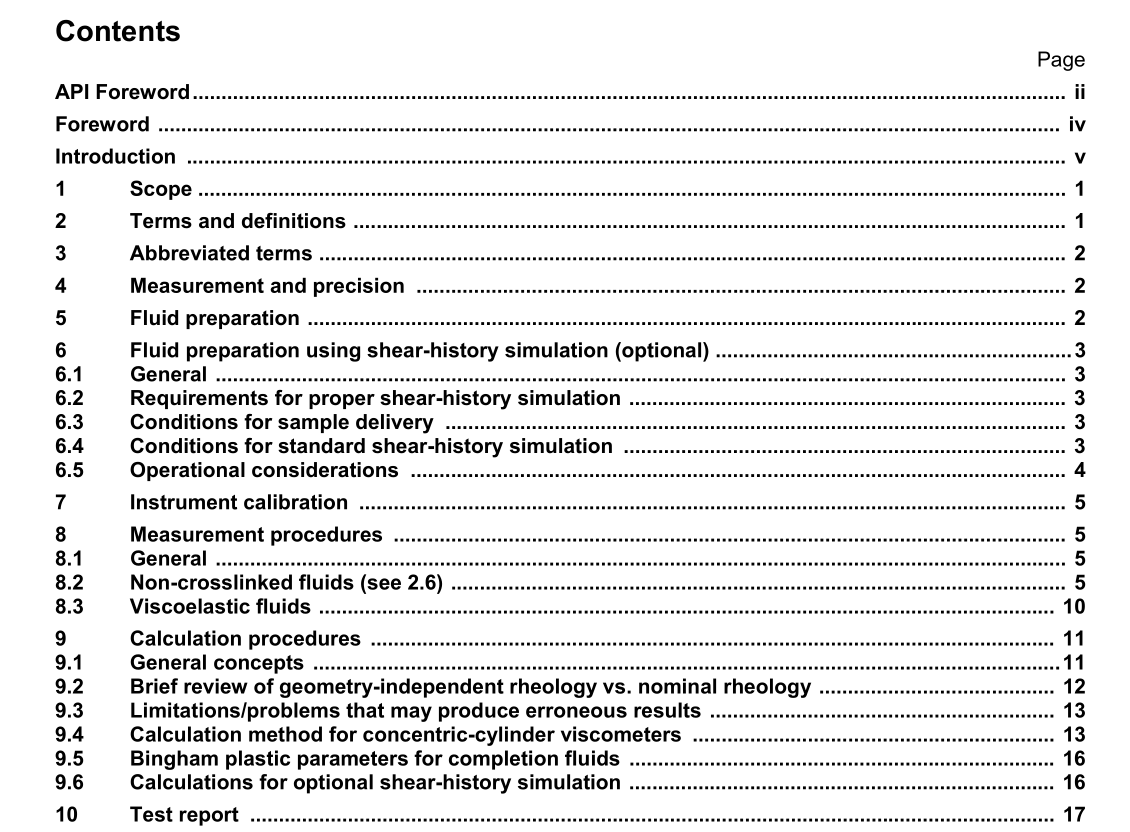ANSI API RP 13M pdf download

ANSI API RP 13M pdf download.Petroleum and natural gas industries — Completion fluids and materials
2 Terms and definitions
For the purposes of this document, the following terms and definitions apply. 2.1 bob fixed inner cylinder of a concentric-cylinder viscometer 2.2 completion fluid any fluid used during the completion phase of a well 2.3 concentric-cylinder viscometer rotational viscometer that consists of a concentric-cylindrical bob and a cylindrical rotor 2.4 elasticity capability of a material to regain its original shape and condition upon removal of an acting stress 2.5 laminar flow flow property of fluids in which all layers of the fluid move parallel to each other and no material is transferred between layers 2.6 non-crosslinked fluid linear, polymer-viscosified solution or any fluid that does not exhibit significant elasticity leading to the Weissenberg effect (“bob climbing”) 2.7 rheology science of the deformation and flow of matter 2.8 shear history sequence of shear rates and temperatures applied to fluids prior to and during measurements 2.9 shear-history simulator apparatus used to simulate shear history in a fluid 2.10 shear rate rate at which one particle of fluid is sliding by another particle divided by the distance between those particles 2.11 shear stress force required to sustain fluid flow 2.12 viscoelastic fluid crosslinked polymer solution or other fluid that exhibits significant elasticity, leading to the Weissenberg effect (bob climbing) 2.13 viscosity measure of the internal friction of a fluid when caused to flow by an external force
6 Fluid preparation using shear-history simulation (optional)
6.1 General A shear-history simulation procedure is provided to simulate the effects of shear rate and time while a fluid is being conveyed down well tubulars. This procedure is intended to characterize the effect of shear history on fluid properties as part of the concept and development phase for a new fluid. A shear-history apparatus is used to condition the fluid at specified shear rates, times and temperatures prior to injection into a viscometer. It consists of mixing apparatus, pumping apparatus and tubing to simulate significant aspects of the surface apparatus followed by shear conditions in the well tubulars. A shear-history apparatus that satisfies the requirements can be generically classified as a tube or pipe flow device that operates in the laminar flow regime. Flow shall occur in a single-pass mode. A schematic diagram of a shear-history simulator connected to a pressurized concentric-cylinder viscometer is shown in Figure 1. In laminar flow, the energy dissipation rate is the same in any shear-history apparatus even if different tubing sizes are used. Thus the design and functioning of the apparatus can vary and still meet the desired preconditioning criteria.6.2 Requirements for proper shear-history simulation The following procedures shall be followed: a) record and report the test temperature; b) ensure thorough mixing of all fluid-activating additive(s) immediately before the fluid enters the shear-history tubing. 6.3 Conditions for sample delivery The following conditions shall be fulfilled: a) continuous delivery of base fluid while additives are added and cup is being filled; b) constant shear rate within the shear-history tubing; c) while fluid is being injected into the viscometer, shear rate within gap of the viscometer is a nominal 100 s −1 .6.5 Operational considerations The following conditions shall be fulfilled: a) the pulsation caused by certain types of positive displacement pumps shall be minimized; b) the base fluid shall be prepared, characterized and reported as described in Clause 5; c) it is critical that a representative sample of the test fluid be injected into the viscometer; therefore initially divert the fluid exiting the shear-history simulator away from the viscometer until stabilized flow and composition are established; d) unions, valves and similar fittings shall have internal diameters such that the shear rate of the fluid flowing through them is essentially the same as within the tubing; e) where the tubing is coiled, the diameter of the coil shall be larger than a critical value (see 9.6.2).









